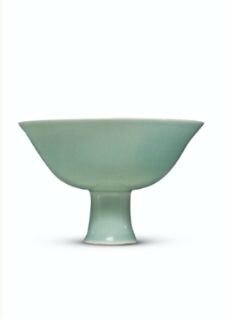A fine and extremely rare 'Wintergreen' glazed stembowl, Ming Dynasty, Yongle Period (1403-1424)
Lot 3028. A fine and extremely rare 'Wintergreen' glazed stembowl, Ming Dynasty, Yongle Period (1403-1424); diameter 15.1 cm, 6 in. Estimate 7,000,000 — 9,000,000 HKD. Lot sold 7,840,000 HKD. Photo: Sotheby's
finely potted, the bowl with steep rounded sides rising to a slightly everted rim, all supported on a splayed hollow stem, delicately applied with a superbly fired flawless, translucent wintergreen glaze of ideal tone, thinning to white at the rim and subtly pooling to a darker shade above the foot, at the joint between the stem and the bowl and just below the rim, the interior of the stem applied with a transparent glaze slightly tinged to green, the footring left unglazed revealing a smooth pure white biscuit.
No other reign – except perhaps the Yongzheng period (1723-35) of the Qing dynasty, three hundred years later – was marked by such innovation in porcelain technology, imagination in design and rigorous pursuit of quality as that of the Yongle Emperor. The imperial porcelain workshops at Jingdezhen in Jiangxi province increased quantity as well as quality of their production with awesome rapidity, as the excavations of waste heaps at the kiln site have documented. As new pigments and firing techniques, new shapes and designs were tried out, the potters’ technical leap forward was so immense, that thereafter no real innovation took place for centuries, until the introduction of foreign technology from the West in the 18th century supplied once more new impulses.
Stembowls had been produced at Jingdezhen already in the preceding Yuan dynasty (1279-1368), but in the Yongle period the proportions were altered and improved to achieve the perfect harmonious balance seen on the present piece. The wide open bowl raised high on a slender stem that slightly expands towards the base for good stability makes for an archetypal offering vessel to be placed in front of religious images on a Buddhist altar.
It is only since the excavations of the Ming imperial kiln site at Jingdezhen began, and the first publications of the finds in the late 1980s revealed the advanced technical standard, level of craftsmanship and aesthetic sophistication of that time, that pieces such as this exquisite stembowl were fully recognized for what they are.
Many different glaze colours were experimented with at the imperial kilns during the Yongle period, but ‘wintergreen’ porcelains are probably the rarest monochrome pieces successfully created. Several tones were achieved, those used for stembowls most closely following the coloration of the finest sea-green 'Longquan' celadons. The glaze colour of the present piece is remarkable for its even colouration, with a subtle natural gradation only where the glaze pools and an attractive white rim where it drains. The imperial kilns attempted to make stembowls in various colours in the Yongle period, but only monochrome white ones were produced in some quantity, and both copper-red and ‘wintergreen’ ones are exceedingly rare.
Only two other 'wintergreen' stem bowls of this type appear to be recorded, one in the Tibet Museum, where many imperial works of art commissioned by the Yongle Emperor for worship in Tibetan Buddhist rituals and sent to Tibet are preserved, the other - slightly damaged - remaining in the Palace Museum, Beijing. For the former see Xizang Bowuguan cang Ming Qing ciqi jingpin/Ming and Qing Dynasties Ceramics Preserved in Tibet Museum, Beijing, 2004, pl. 26; the latter is published in Geng Baochang, ed.,Gugong Bowuyuan cang gu taoci ziliao xuancui [Selection of ancient ceramic material from the Palace Museum], Beijing, 2005, vol. 1, pl. 88.
The Palace Museum also owns a closely related piece, with a 'bamboo segment' ridge around the stem, illustrated in The Complete Collection of Treasures of the Palace Museum. Monochrome Porcelain, Hong Kong, 1999, pl. 124 (fig. 1), and a second bowl of this type was sold in our London rooms, 7th April 1981, lot 252 and again in these rooms, 11th May 1983, lot 105.
fig. 1. ‘Wintergreen’ Glazed Stembowl, Ming Dynasty, Yongle Period, Palace Museum, Beijing. After: The Complete Collection of Treasures of the Palace Museum. Monochrome Porcelain , Hong Kong, 1999, Pl. 124
Like with white and red examples, green ones were created both with and without reign mark. A single ‘wintergreen’ example with anhua dragons around the interior and a four-character Yongle mark incised in the centre of the bowl was sold in these rooms 24th November 1981, lot 133, and again in our New York rooms, 22nd March 2001, lot 90 (fig. 2).
fig. 2. ‘Wintergreen’ Glazed Stembowl, Seal Mark and Period of Yongle. Sotheby’s New York, 22nd March 2001, Lot 90
After the Yongle period this subtle coloration, which requires impeccably prepared materials and utmost control of the firing, was soon abandoned and properly revived only in the Yongzheng reign. It must have been pieces such as this bowl that caught the Yongzheng Emperor’s eyes and served as model for the fine celadon-green monochromes that are one of the best porcelains of that reign.
Sotheby's. Fine Chinese Ceramics and Works of Art, Hong Kong, 08 Oct 2013

/https%3A%2F%2Fprofilepics.canalblog.com%2Fprofilepics%2F1%2F0%2F100183.jpg)
/https%3A%2F%2Fstorage.canalblog.com%2F03%2F02%2F119589%2F96711876_o.jpg)
/https%3A%2F%2Fstorage.canalblog.com%2F11%2F31%2F119589%2F94773502_o.jpg)
/https%3A%2F%2Fstorage.canalblog.com%2F20%2F83%2F119589%2F94772815_o.jpg)
/https%3A%2F%2Fstorage.canalblog.com%2F26%2F72%2F119589%2F75604929_o.jpg)
/https%3A%2F%2Fstorage.canalblog.com%2F59%2F60%2F119589%2F26458628_o.jpg)






/image%2F1371349%2F20240421%2Fob_1dddd2_438878301-1654314112005268-81048289869.jpg)
/image%2F1371349%2F20240421%2Fob_df8c96_438328730-1653747745395238-34643333091.jpg)
/image%2F1371349%2F20240417%2Fob_961e87_437772831-1653147868788559-54808306367.jpg)
/image%2F1371349%2F20240417%2Fob_cd839f_438802798-1652979072138772-16612847234.jpg)